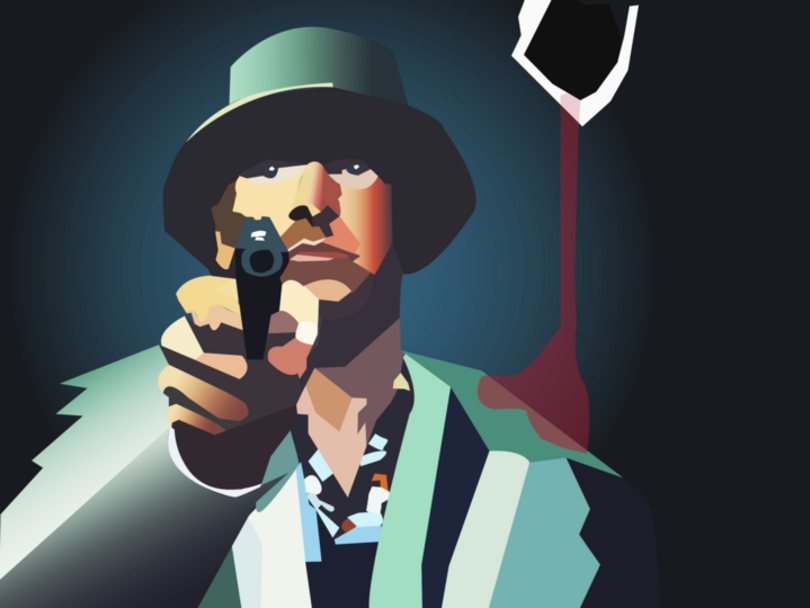‘The Killer’ is another thrilling, oddly funny David Fincher film

Xanthe Kakaras | Contributing Illustrator
Michael Fassbender plays a dorky assassin in David Finchers’s newest film, “The Killer.” This movie plays into Fincher’s style of highlighting obsessiveness in his characters.
Get the latest Syracuse news delivered right to your inbox.
Subscribe to our newsletter here.
As far as we know, David Fincher isn’t an assassin. But his latest directorial work, “The Killer,” feels like a personal work. He makes the act of killing not just a visually compelling experience but a job that has to be completed with expert precision.
On the surface level, the film, which came out on Netflix last Friday, is a simple action film about an unnamed methodical killer (Michael Fassbender) who goes on a revenge tour after his girlfriend, Magdala (Sophie Charlotte), is punished because he failed a hit job.
If you dare to look deeper, though, you’ll find that Fincher and Fassbender’s characters are similar; both the real-life director and the fictional hitman have reputations for being total control freaks. But with the killer, this desire to stick to the plan ends up comically backfiring.
The film, based on a French comic book of the same title, gives Fincher the opportunity to display his technical prowess and simultaneously make fun of himself. Even though it’s a dark action thriller, it feels like a masterclass in the art of self-deprecation.
Fincher has earned the reputation of being a perfectionist like Stanley Kubrick. Both directors are notorious for the relentless number of takes they do while making their movies. A prime example of this is when Jake Gyllenhaal had to do as many as 70 takes of certain scenes in “Zodiac,” pushing the actor to the limit and building tension on set. It’s a distinction that Fincher himself is aware of and rejects. In an interview with the New York Times in 2020, Fincher said there is a difference between “mediocre and acceptable.”
Fincher and screenwriter Andrew Kevin Walker, who collaborated with the director on 1995’s “Se7en,” take this character archetype to a comedic extreme.
The film opens with a 20-minute scene of the unnamed killer waiting in and around an abandoned WeWork in Paris for his target. Through voiceover, he explains his detailed process, including how listening to The Smiths helps him find comfort and how doing yoga helps him stay focused.
 Fernanda Kligerman | Design Editor
Fernanda Kligerman | Design Editor
He says certain phrases like “Stick to your plan,” “Anticipate, don’t improvise,” “Trust no one,” “Never yield an advantage” and “Fight only the battle you’re paid to fight,” that he eventually repeats throughout the whole movie. While the monologue sounds ominous and brooding, it eventually makes the killer sound like a silly control freak.
In his own words, the killer’s process is purely logistical and focused by design. He won’t pick sides, he just does his job to the best of his capabilities. The killer is a cynic and doesn’t believe there is any basis in the idea that there is inherent goodness in people.
It sounds an awful lot like how Fincher approaches filmmaking and the business of Hollywood. Unlike his peers Quentin Tarantino and Paul Thomas Anderson, Fincher has embraced digital cameras as part of his cinematography.
Fincher also made the jump to Netflix in 2013 to produce the first streaming show to be labeled a Netflix Original, “House of Cards,” signaling the new era of how movies and shows are created and distributed. Fincher has made these moves out of a sense of austere pragmatism.
Both Fincher and the killer are similar in this respect. Thus, by making the killer a cynical control freak who can’t let anything go right, Fincher shows he is capable of making fun of himself. This is the man, after all, who said “All people are perverts.”
Fincher takes this a step further with the performance of Fassbender. The protagonist of this film desperately wants to seem like he’s just a hard worker who is good at his job, just like anyone else. He narrates that he is like a common middle-class worker, even as he takes hit, people like the billionaire Claybourne (Arliss Howard).
Fincher explicitly told Fassbender to be “dorky.” Fassbender, who hasn’t been in a film since 2019, plays a secluded man who wants to seem like he’s normal but is most definitely not.
If Fincher is making Fassbender’s character, who compares himself to baseball legend Ted Williams and fails to live up to the comparison, a dork, then Fincher is saying he himself is kind of a dork.
Most prominently, though, the initial sequence features the classic Fincher cinematography, where the camera smoothly follows the character’s every movement. Once the hit goes awry, the camera becomes shaky as the killer escapes from the scene of the crime. The rest of the film features this style that gives the viewer a glimpse inside the mind of Fassbender’s character.
It’s not that Fincher hasn’t used the cinematographic technique before. In the climactic scene of “Se7en,” the camera shakes violently as John Doe gets the upper hand. But the excessive amount of shaky cam in “The Killer” serves as a total subversion of Fincher’s previous works.
Fincher knows that his precise camera movements are part of how he wants his films to feel omniscient. If a Fincher character feels a certain way, then the director wants the camera movement to reflect that. With Fincher subverting his own style in his latest movie, he makes a conscious effort to move away from what has made him famous.
As the killer travels around the globe, visiting his boss (Charles Parnell) and his assistant (Kerry O’Malley), the assassins that attacked his girlfriend (Tilda Swinton, Sala Baker) and Claybourne, he becomes more of a vessel for Fincher. Even though Fincher and Fassbender’s characters succeed in their respective fields, they are still kind of dorks.
It’s self-deprecation at its finest from one of the best working directors today. If you don’t find Fassbender saying “living amongst the normies” during a narration funny, then maybe this film is not for you.
As a reflection of one of Hollywood’s finest technicians, Fincher makes “The Killer” into a sleek, thrilling and oddly funny film that fits just right into his filmography.





